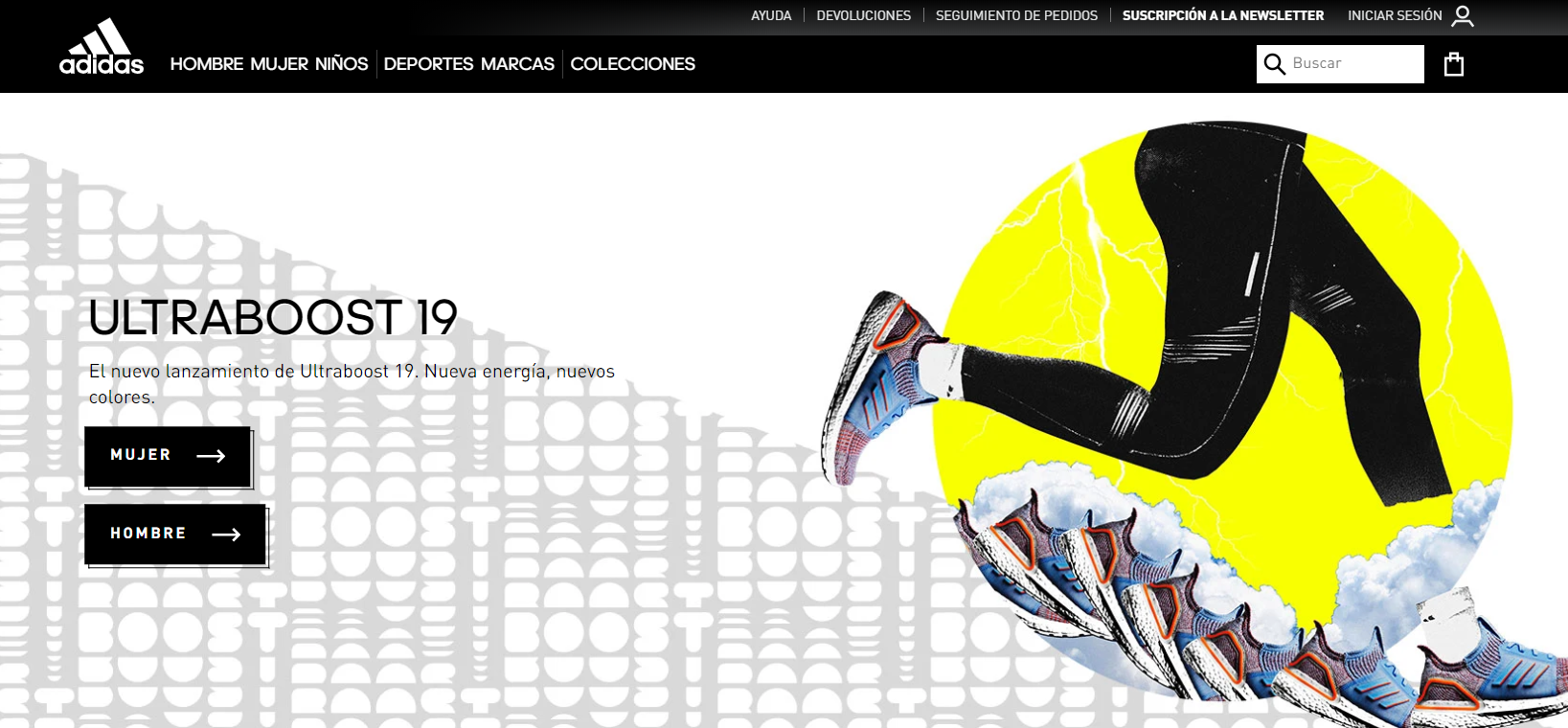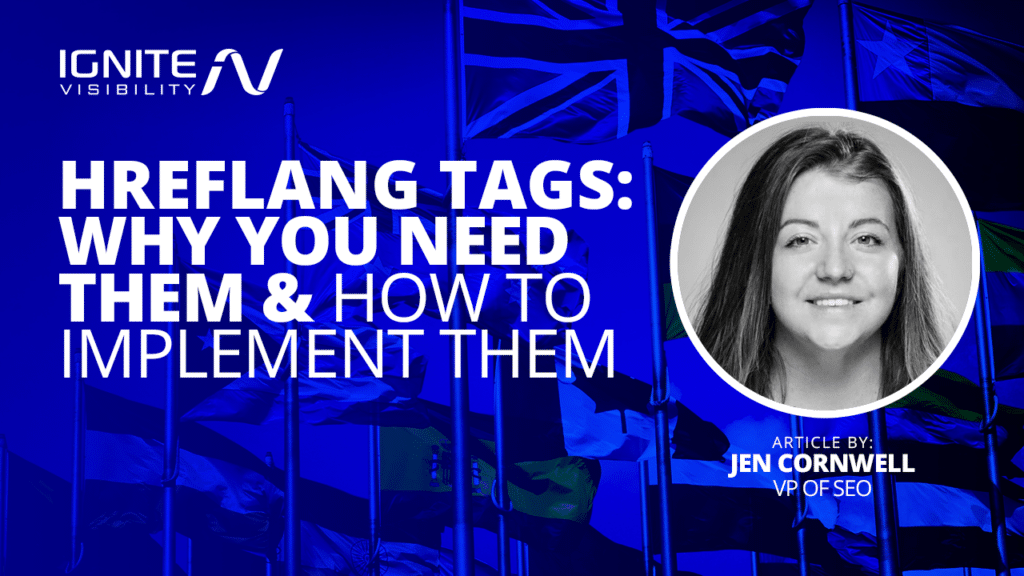
Hreflang tags.
This strange-sounding combination of words comes with some major international SEO benefits.
Learn what hreflang tags are, why you might need them, and how to correctly add them to your site.
What You’ll Learn:
- What Is An Hreflang Tag?
- Breaking Down the Basics of Hreflang Tags
- How to Add Hreflang Tags to Your Site
- Hreflang and SEO
- Conduct A Hreflang Audit
- Common Mistakes To Avoid When Implementing Hreflang Tags
- FAQs About Hreflang Tag Attributes
What Is An Hreflang Tag?
Google introduced the hreflang attribute in 2011 as a method of marking up the content on your website for international users. They are a crucial part of a website’s code that assists search engines with understanding the language and geographic location of your site visitors.
It helps search engines understand the language and location of your site visitors, making it easier for them to serve relevant content in their local language.
The “href” stands for a hyperlink reference, and “lang” is short for language.
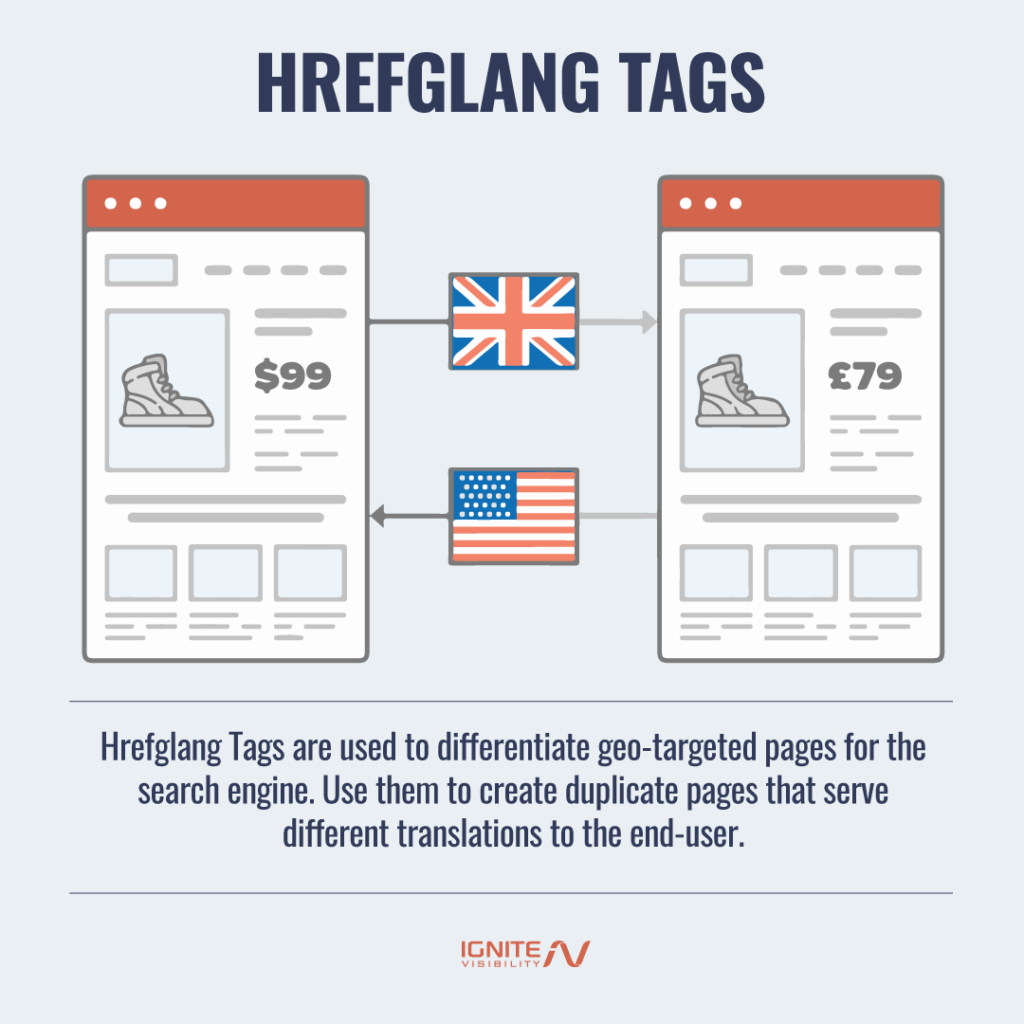
Hreflang Tags
Our Expert’s Opinion on Hreflang Tags
Our VP of SEO, Jen Cornwell knows how important hreflang tags are when it comes to international SEO. “Hreflang tags are often overlooked aspects of web optimization, holding immense power, ensuring search engines correctly understand linguistic and regional variations of your content.”
These tags serve as a beacon for search engine crawlers, guiding them to deliver the most relevant version of your content to users based on their location and language preferences.
This functionality is particularly vital for multinational businesses, ecommerce platforms, and organizations targeting diverse linguistic markets.
While there are many benefits to using these tags, here are just a few favorites:
- Enhances User Experience – Visitors are more likely to engage with content in their native language
- Avoids Duplicate Content – Prevents search engines from perceiving content in different languages or regions as duplicate
- Targets Localization Efforts – Tailors SEO strategies to specific regions
- Maximizes Organic Traffic – Sends users to the most relevant version of your content
How Do Hreflang Tags Work?
You can imagine hreflang tags as a global positioning system (GPS) that indicates the language and geography of a particular webpage.
For example, if you have a webpage in English, and the same page is also available in Spanish on your website, you can use these tags to inform the search engines about this multilingual setup.
For example:
Googling “Apple” in the U.S., will provide a search result that looks like this:

Google “Apple” in US
But Googling “Apple” in Spain will result in a search result that has a different URL, like the image below.

Google “Apple” in Spain
Just like you would use a GPS to guide users to specific locations, these tags guide search engines to the correct version of your content based on the user’s language or geographical location.
Here’s another example.
If you Google “Adidas” in the U.S., this is the landing page that pops up at the top of the search results:
But if you Google “Adidas” in Spain, the top result will take you here:
In a nutshell, hreflang tags are critical to ensure that your content is accurately indexed and served appropriately to international and multilingual audiences.
Who Should Use a Hreflang Tag? And When?
According to the Google Search Central documentation, you should use hreflang to inform Google of the variations of your content, enabling Google to understand that these pages are localized variations of the same content. Typically, you should use hreflang tags:
- Website versions: Website versions can exist in different subdirectories on the same domain, within their own subdomain, or on separate domains altogether.
- Language: Per Google specifications, versions of a website can be assigned one language. Make sure you don’t mix and match languages within any of your websites.
- Regions: Websites can target a country or region. This designation applies when you have multiple regions that speak the same language but have differences when it comes to currency, culture, or content.
Where Do Hreflang Tags Go?
Hreflang tags can be implemented in three different locations within your website’s structure:
1. HTML <head> Section: You can place the tags within the <head> section of each related web page. This is a common method and involves adding a <link> element with the appropriate hreflang and href attributes.
2. HTTP Header: For non-HTML files like PDFs, you can implement hreflang tags within the HTTP header instead. To do this, use the “Link” header, combined with the “rel” and “hreflang” attributes.
3. XML Sitemap: You can also add hreflang tags to your XML sitemap by including <xhtml:link> elements with the rel, hreflang, and href attributes for each language or regional URL.
Key Reasons to Use Hreflang Tags
Language Specification: They tell search engines about the language used on a particular webpage, thus allowing the search engine, like Google, to serve the appropriate content to users who search in that specific language.
Geographical Targeting: These tags are used to specify the geographical targeting of a webpage. For instance, if your page has different versions intended for users in the US, Canada, and the UK, you can specify these geographical targets using the hreflang tags.
Handling Multiple Language Versions: If your website features several language versions that are targeted at particular countries or regions, hreflang tags help search engines understand this relationship between the pages.
Improved User Experience & SEO: Using hreflang tags optimizes user experience by ensuring the user gets content based on their country and language preference. They also lead to improved search rankings since it helps with personalizing results.
Reduced Duplicate Content Issues: Tag attributes can help to improve your SEO by reducing duplicate content issues, leading to improved search rankings.
Localized Content Preference: 55% of internet users prefer to buy in their own language. Hence, using hreflang tags to deliver localized content on your website can lead to increased user satisfaction and potentially increase conversions.
Maintain Website Speed: By adding alternate URLs to your sitemap specifically, they will be found faster. XML tagging won’t slow down your site like the other methods.
Thus, if you have content in multiple languages or for different geographies, hreflang tags are a crucial tool for ensuring that the appropriate content is served to the right users.
How to Add Hreflang Tags to Your Site
If you want to know how to implement hreflang tags on your site, you can follow the steps below:
1. Research Language and Country Codes: Ensure you understand the correct language and country codes to use. This includes codes like “en-us” for English-language content targeted to the United States, or “fr-fr” for French-language content targeted to France.
2. Decide on Implementation Method: Choose whether you’ll add the hreflang tags to the HTML <head> section, HTTP header, or XML Sitemap.
- HTML <head> Implementation: Add link elements to the <head> section of each page containing rel=“alternate”, hreflang=“x”, and href=“URL”. Replace “x” with the language-country code and “URL” with the URL of the translated page.
- HTTP Header Implementation: For non-HTML files like PDFs, use the “Link” HTTP header combined with rel=“alternate”, hreflang=“x”, and href=“URL”.
- XML Sitemap Implementation: If you prefer, you can add hreflang tags to your XML Sitemap for each URL. This is particularly useful for larger sites with lots of multilingual content.
- WordPress Implementation: If you’re using WordPress, you can use the hreflang tags WordPress Plugins to help you implement the hreflang tags.
Remember to replace each hreflang tag as needed for all language versions of a page. You can validate your implementation using a tool like a Hreflang Tags Testing Tool.
After you’ve implemented the hreflang tags, Google and other search engines will use this information to serve the correct language or regional URL to the user.
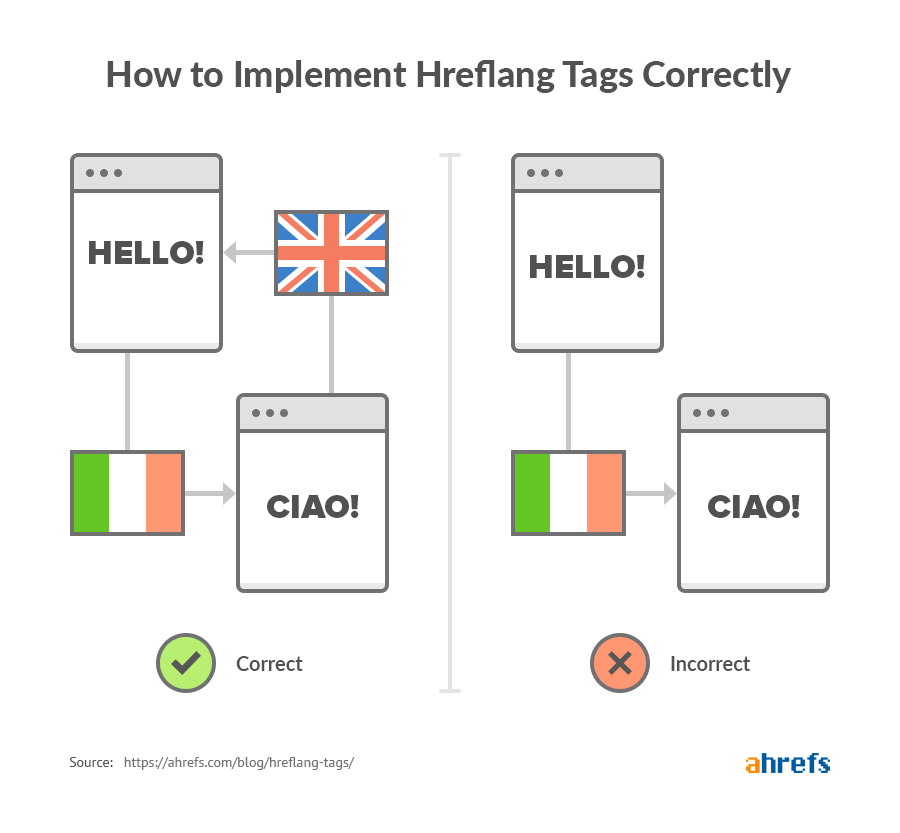
Hreflang tags are bidirectional
Hreflang and SEO
In the realm of search engine optimization (SEO), there exist two powerful tools that are often misunderstood or used incorrectly: hreflang tags and canonical tags.
Hreflang Tags
So, how does this relate to duplicate content?
In simple terms, duplicate content means substantially identical content appearing on the Internet in more than one location. For SEO, this is a problem. If you have the same content on various pages of your site, search engines will have trouble figuring out which version is more relevant to a given search query.
Simply put, by using hreflang, you allow search engines to understand the relationship between different language versions of your page. This way, the search engines don’t perceive your translated content as duplicate content.
Canonical Tags
Canonicalization, on the other hand, deals with duplicate or similar content across multiple URLs. A canonical tag (rel=canonical) placed within the HTML header of a webpage tells search engines that this URL is the “master” or original version of multiple similar pages.
When a search engine crawls multiple similar pages, it consolidates the link signals for the canonical version and treats it as the most relevant result to show in search engine result pages (SERPs).
Building a Better International SEO Strategy
Even though hreflang and canonicalization serve different purposes, they work together to form an effective international SEO strategy.
For example, if your website has both English and Spanish versions and you have used hreflang tags to differentiate them, you would then use canonical tags within each of these “language clusters” to define which of the pages within that language or the region is the master version.
By doing so, you’re effectively telling search engines, “For my users in the US, this is the original English page to index, and for my users in Mexico, this is the original Spanish page to index.”

International SEO Hreflang and Canonical
Conduct A Hreflang Audit
Start by checking Google Analytics check the location report to see how (and honestly, if) your international traffic is making its way to your site.
To access this report, navigate to Reports > User > User Attributes > Demographic Details.
Here, you’ll be able to see which landing pages and keywords are bringing new visitors to your site and can review these numbers in comparison to your pre-hreflang performance.
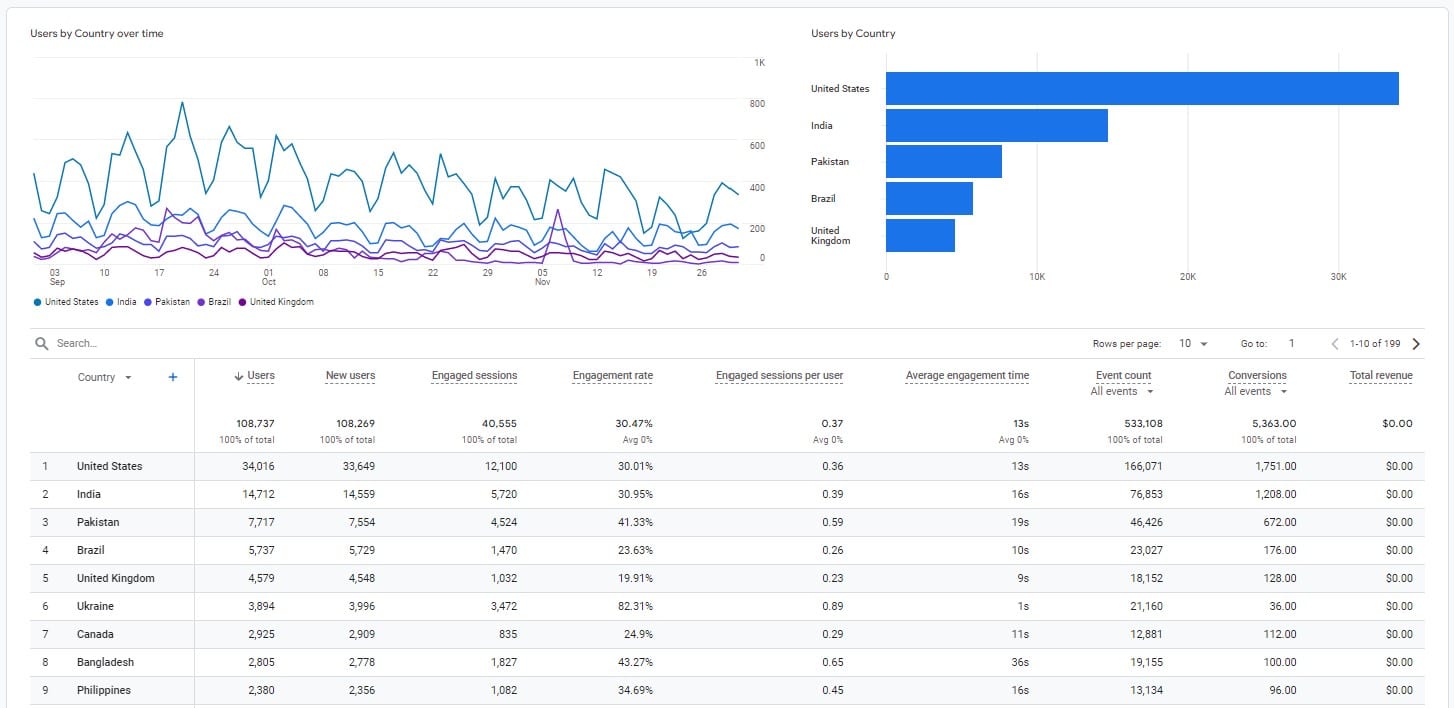
Google Analytics 4 – Users By Country
You can also do the same for languages.
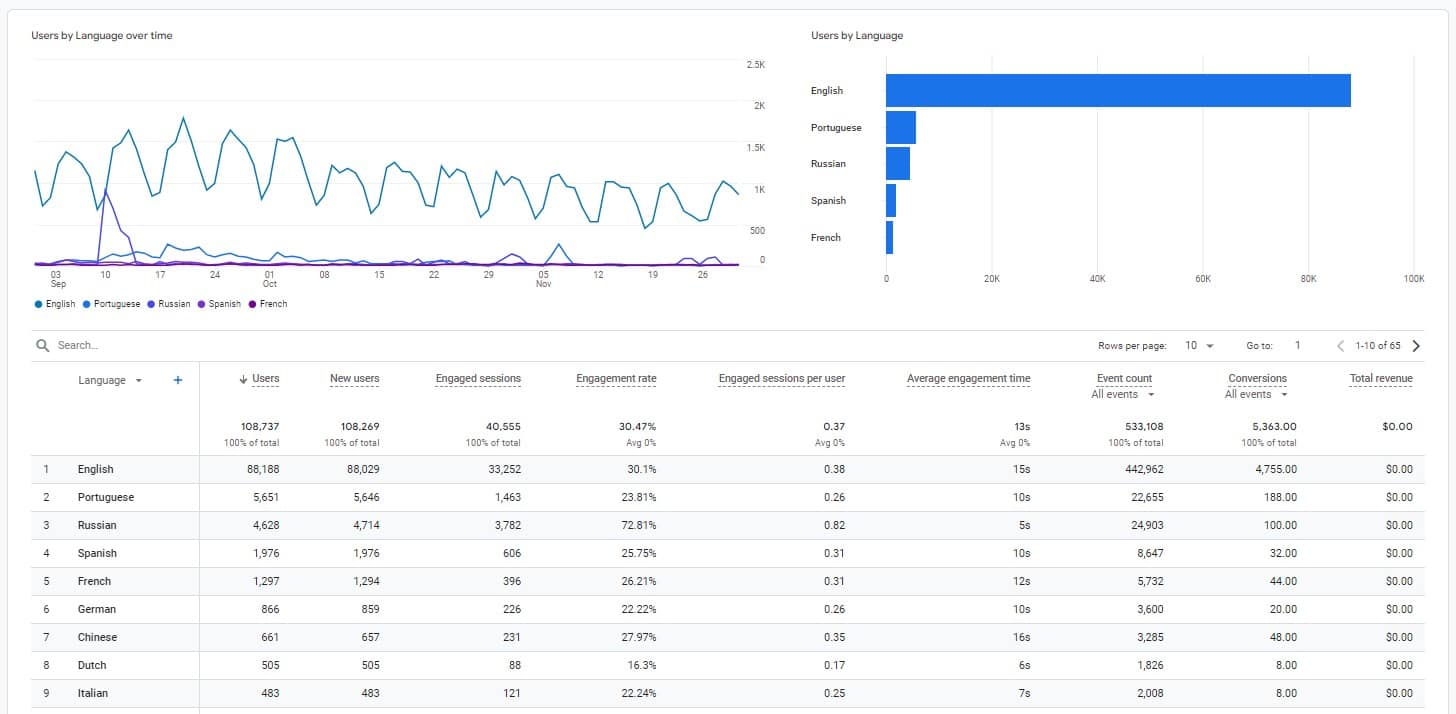
Google Analytics 4 – Users By Language
Tools like SEMRush and Search Metrics can also be used to review your international SERP performance for additional insights.
Consult Your Google Search Console International Targeting Report
You can debug any hreflang errors from your Google Search Console International Targeting Report. This report is designed to uncover any hreflang errors found in your sitemap.
Pro-Tip: Before running a report, make sure that enough time has passed to ensure that Google has crawled your sitemap.
Navigate to the language tab to see if the crawl picked up on any errors–be it in the sitemap, HTTP headers, or page-level tags.
Additionally, several third-party tools can help you detect any additional errors associated with your hreflang tagging.
Common Mistakes To Avoid When Implementing Hreflang Tags
When implementing hreflang tags, there are several common mistakes you should avoid to ensure optimal results:
- No return hreflang tag: Always include return tags that link back to the original page.
- No self-referencing tags: Ensure every page also has an hreflang tag referencing itself.
- Wrong country/language codes: Double-check that you are using the correct ISO codes for language and country targeting.
- Hreflang tags punctuation errors and typos: Proofread tags to minimize errors that could result in incorrect language targeting or non-functioning hreflang links.
- Missing x-default tag: Implement the x-default tag to provide a default version if no other language matches the user’s preferences.
- Invalid hreflang URLs: Verify that all hreflang URLs are valid and accessible.
- Incorrect canonical implementation: Ensure that the canonical URL is correct and does not conflict with hreflang directives.
- No absolute URLs: Use absolute (complete) URLs rather than relative (partial) URLs in hreflang tags.
- Blocked pages: Ensure that hreflang-tagged pages are not blocked by robots.txt or restricted by meta robots tags.
- Combining different tagging methods: Be consistent with your hreflang implementation to avoid confusion for search engines.
FAQs About Hreflang Tags
1. Do hreflang tags impact user experience?
For multilingual websites, hreflang tags are especially important in reducing bounce rates from users who search in a foreign language but wish to find a website in their preferred language. By providing users with the right content in the right language, hreflang tags can improve user satisfaction and increase engagement.
By implementing hreflang tags correctly, website owners can improve language targeting, enhance user experience, and ultimately boost search engine visibility.
2. Can hreflang tags affect your site’s load time?
Hreflang tags do not operate on the front end and are not part of the elements that a browser loads when a user visits a webpage. But like any SEO implementation, they should be used correctly to avoid potential errors or issues that might indirectly impact user experience and website load time.
3. Do all search engines recognize hreflang tags or just Google?
Not all search engines recognize hreflang tags. Currently, these attributes are recognized by Google and Yandex. Google supports tags implemented through HTML link elements in the header, HTTP headers, or XML sitemaps. Likewise, Yandex recognizes hreflang tags through HTML link elements and HTTP headers but does not acknowledge them if implemented via XML sitemaps.
It’s worth noting that Bing does not formally recognize hreflang tags and primarily relies on the content-language HTML attribute, links, and user analytics to discern language. However, Bing continues to recommend using hreflang tags in their official documentation.
4. How often should you review and update hreflang tags?
It is crucial to update hreflang tags whenever there is a significant change on your website. Changes in the structure of your website, the addition or removal of certain web pages, and changes in your website’s content targeted to different regions or languages can all affect performance.
5 . What alternatives are there to hreflang for managing multilingual content?
- Google’s Algorithms: Rely on Google’s language detection algorithms by optimizing translation quality and minimizing auto-translated content.
- Language-Specific URLs: Create separate domains, subdomains, or subdirectories for each language version.
- Alternate Attributes: Use data-attribute, data-interchange, or data-translation for template translations, especially on forums.
- Canonical Tags: Implement canonical tags with hreflang for improved SEO performance in multilingual websites.
6. What are the best practices for hreflang tagging for mobile websites?
- Correct implementation: Ensure hreflang tags are correctly implemented and that language codes align with ISO standards.
- Duplicate for mobile: Use the same hreflang tags from your desktop site on your mobile version. Google treats mobile and desktop pages separately.
- Monitor: Regularly check and optimize your hreflang tags to avoid SEO issues.
7. How do hreflang tags interact with other SEO strategies like schema markup?
Hreflang tags highlight different language versions of a page, ensuring search engines serve the right language to users. On the other hand, schema markup gives search engines detailed information about a webpage’s content for more informative search results.
Improve Your International SEO with Ignite Visibility Today
Whether you’re looking to boost your SEO, optimize your website, or supercharge your digital ads, Ignite has you covered.
Ignite Visibility can help you:
- Develop a custom guide to international SEO strategies that drive online conversion
- Connect with audiences in their native language
- Fix errors related to autogenerated translated content
- Identify and correct international SEO targeting errors
Ready to chat? Reach out today to start building your SEO plan.

